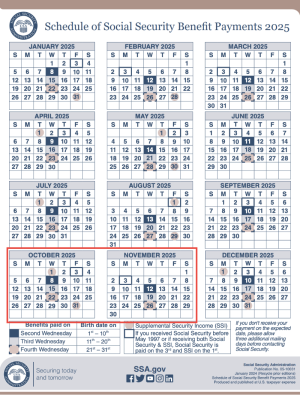Why you won’t see a Social Security SSI payment in November—here’s what to know
By
Veronica E.
- Replies 0
If you receive Supplemental Security Income (SSI), you may have noticed some confusing messages about a missing payment in November.
Don’t worry—this isn’t a new rule, and it doesn’t mean your benefits are being reduced or canceled.
In fact, your payment is still coming, just earlier than usual.
It all comes down to how the calendar lines up this year.
Here’s a clear breakdown of what’s happening, and how you can plan for it.

This year, November 1 falls on a Saturday.
Because the Social Security Administration (SSA) doesn’t issue payments on weekends or federal holidays, your SSI benefit will be paid a day earlier—on October 31.
That’s why it might look like there’s no November payment when, in reality, you’re simply getting it a day early.
Since you’ll receive October’s payment at the beginning of the month and November’s at the end, October will appear to be a “double payment” month.
It’s important to note this isn’t extra money—it’s just a shift in timing.
If you rely on your monthly benefit to cover essential costs, be sure to budget so that the second October deposit carries you through November.
These early payments aren’t unusual.
Whenever the first of the month lands on a weekend or holiday, the SSA pays benefits on the last business day before that date.
It happened earlier this year in August, when September’s payment arrived early because of Labor Day.
And it’ll happen again in December—January 1 is a federal holiday, so the January 2026 payment will go out on December 31.
There’s an upside to the early December payment.
That deposit will include the 2026 cost-of-living adjustment (COLA), which is currently estimated at 2.8%.
This increase would raise the maximum monthly SSI benefit to about $1,490 for individuals and more for couples.
Final COLA figures will be announced in October.
For 2025, the maximum SSI benefit is $967 per month for individuals and $1,450 for couples.
Your actual benefit may vary depending on your income, household situation, and other factors.
Most recipients must have monthly earnings below $2,019 to qualify, and some children with qualifying disabilities may also be eligible.
As of late September, a change in available payment methods affected some beneficiaries.
If you haven’t checked your account details lately, it’s a good idea to confirm everything is current with the SSA.
Most recipients now receive their SSI through direct deposit or a government-issued debit card—both are safe and reliable.

Early payments can be helpful if you’re prepared.
Here are a few ways to make sure the timing works in your favor:
Plan ahead when payment dates shift due to weekends or holidays—it’s all part of the SSA’s regular schedule.
There’s no need for concern about your November SSI benefits—this is simply a routine schedule adjustment.
By keeping track of early payments and budgeting accordingly, you can manage your monthly finances with confidence and clarity.
Read next:

Have you had a double SSI payment month before? How do you handle early payments in your budget? Do you use reminders to track payment dates? And are you planning ahead for the upcoming COLA increase? Let us know in the comments below—your experience could be helpful to others.
Don’t worry—this isn’t a new rule, and it doesn’t mean your benefits are being reduced or canceled.
In fact, your payment is still coming, just earlier than usual.
It all comes down to how the calendar lines up this year.
Here’s a clear breakdown of what’s happening, and how you can plan for it.

Marking your calendar can help you stay on top of early SSI payment dates and avoid budgeting surprises. Image Source: YouTube / CBS Mornings.
Why the November payment is arriving in October
This year, November 1 falls on a Saturday.
Because the Social Security Administration (SSA) doesn’t issue payments on weekends or federal holidays, your SSI benefit will be paid a day earlier—on October 31.
That’s why it might look like there’s no November payment when, in reality, you’re simply getting it a day early.
Two payments in October—but one is for November
Since you’ll receive October’s payment at the beginning of the month and November’s at the end, October will appear to be a “double payment” month.
It’s important to note this isn’t extra money—it’s just a shift in timing.
If you rely on your monthly benefit to cover essential costs, be sure to budget so that the second October deposit carries you through November.
Also read: White House responds to Social Security change concerns
This happens regularly
These early payments aren’t unusual.
Whenever the first of the month lands on a weekend or holiday, the SSA pays benefits on the last business day before that date.
It happened earlier this year in August, when September’s payment arrived early because of Labor Day.
And it’ll happen again in December—January 1 is a federal holiday, so the January 2026 payment will go out on December 31.
A raise may be coming with the December 31 payment
There’s an upside to the early December payment.
That deposit will include the 2026 cost-of-living adjustment (COLA), which is currently estimated at 2.8%.
This increase would raise the maximum monthly SSI benefit to about $1,490 for individuals and more for couples.
Final COLA figures will be announced in October.
Also read: Social Security after retirement: 6 Smart moves to make
2025 SSI payment amounts
For 2025, the maximum SSI benefit is $967 per month for individuals and $1,450 for couples.
Your actual benefit may vary depending on your income, household situation, and other factors.
Most recipients must have monthly earnings below $2,019 to qualify, and some children with qualifying disabilities may also be eligible.
Update your payment method if needed
As of late September, a change in available payment methods affected some beneficiaries.
If you haven’t checked your account details lately, it’s a good idea to confirm everything is current with the SSA.
Most recipients now receive their SSI through direct deposit or a government-issued debit card—both are safe and reliable.

A quick glance at the calendar can help explain why SSI payments sometimes arrive earlier than expected. Image Source: SSA.
Also read: New lawsuit demands answers on Social Security changes and transparency
Budgeting tips for early payments
Early payments can be helpful if you’re prepared.
Here are a few ways to make sure the timing works in your favor:
- Budget mindfully: Remember, the second October payment is for November—don’t spend it all at once.
- Mark your calendar: Knowing when to expect early deposits can help you avoid surprises.
- Keep an eye on COLA: If your benefit increases in January, plan how you’ll use the extra funds wisely.
- Stay connected: Check the SSA’s online schedule or call their support line if anything seems unclear.
Plan ahead when payment dates shift due to weekends or holidays—it’s all part of the SSA’s regular schedule.
There’s no need for concern about your November SSI benefits—this is simply a routine schedule adjustment.
By keeping track of early payments and budgeting accordingly, you can manage your monthly finances with confidence and clarity.
Read next:
- What Social Security really looks like at 72 in 2025
- Get ready for a Social Security update: When the 2026 COLA will be announced
- Don't lose your benefits! Discover which Social Security services you can still access during a government shutdown
Key Takeaways
- There will be no SSI payment issued on November 1 because it falls on a Saturday—the payment will arrive early on October 31 instead.
- October will have two payments, but the second one covers November, so recipients should budget accordingly.
- Early payments like this happen whenever the first of the month falls on a weekend or federal holiday; the next one will be in December.
- The January 2026 payment, issued on December 31, will include the expected 2.8% COLA increase, raising the maximum monthly benefit.
Have you had a double SSI payment month before? How do you handle early payments in your budget? Do you use reminders to track payment dates? And are you planning ahead for the upcoming COLA increase? Let us know in the comments below—your experience could be helpful to others.






